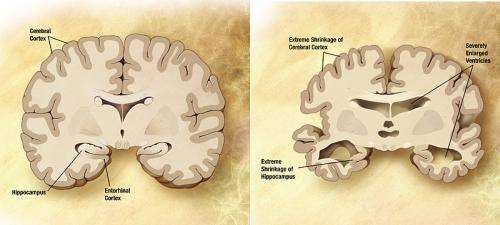Different forms of Alzheimer's have similar effects on brain networks

(Medical Xpress)—Brain networks break down similarly in rare, inherited forms of Alzheimer's disease and much more common uninherited versions of the disorder, a new study has revealed.
Scientists at Washington University School of Medicine in St. Louis have shown that in both types of Alzheimer's, a basic component of brain function starts to decline about five years before symptoms, such as memory loss, become obvious.
The breakdown occurs in resting state functional connectivity, which involves groups of brain regions with activity levels that rise and fall in coordination with each other. Scientists believe this synchronization helps the regions form networks that work together or stay out of each other's way during mental tasks.
"The brain networks affected by inherited Alzheimer's disease in a 30-year-old are very similar to the networks affected by uninherited Alzheimer's disease in a 60-, 70- or 80-year-old," said senior author Beau Ances, MD, PhD. "This affirms that what we learn by studying inherited Alzheimer's, which appears at younger ages, will help us better understand and treat more common forms of the disease."
The research appears online in JAMA Neurology.
According to Ances, the results show that functional connectivity may help scientists monitor the effects of treatment as patients progress through the transition between early disease and the first appearance of obvious symptoms.
"Right now, this period when functional connectivity begins breaking down is a time when family and loved ones may start noticing little changes in personality or mental function in someone with the disease, but not significant enough changes to cause real alarm," Ances said. "The hope is that one day treatment already will be well underway before these sorts of changes begin—we want to slow or stop the damage caused by Alzheimer's years earlier."
Inherited Alzheimer's disease can strike very early in life, causing symptoms in patients as young as their 30s or 40s. Identifying the mutations that cause these forms of the disease has helped scientists find proteins that become problematic in more common forms of Alzheimer's, which typically appear decades later.
Researchers have long assumed that additional connections exist between inherited and uninherited Alzheimer's disease, but until recently they have not had sufficient data to directly test many of those connections. Challenges have included the small number of people with inherited Alzheimer's, and the slow development of both forms of the disease.
Scientists at the Charles F. and Joanne Knight Alzheimer's Disease Research Center at Washington University began to tackle the first challenge five years ago by organizing the Dominantly Inherited Alzheimer's Network (DIAN), an international network for identifying and studying families with inherited forms of the disease. The network now includes nearly 400 families.
To address the second challenge, Washington University researchers at the center have been gathering extensive health data on seniors through long-term projects such as the Healthy Aging and Senile Dementia Study, which is entering its 31st year.
These pools of data allowed Ances, an associate professor of neurology, to compare the effects of inherited and uninherited Alzheimer's on functional connectivity. Scientists assess functional connectivity by scanning the brains of research participants while they daydream.
"The question was, where does the decline of functional connectivity fit in the whole picture of the development of Alzheimer's disease?" Ances said. "And it clearly does have a place in the middle stages of the disease."
That's not the best place to look for an initial diagnosis, according to Ances. Ideally, scientists want to start treating Alzheimer's disease as soon as possible.
"What this does tell us, though, is that functional connectivity may help us track the progression of Alzheimer's in patients who are first diagnosed when they're beginning to show early signs of dementia," he said.
More information: Thomas JB, Brier MR, Bateman RJ, Snyder AZ, Benzinger TL, Xiong C, Raichle M, Holtzman DM, Sperling RA, Mayeux R, Ghetti B, Ringman JM, Salloway S, McDade E, Rossor MN, Ourselin S, Schofield PR, Masters CL, Martins RN, Weinger MW, Thompson PM, Fox NC, Koeppe RA, Jack CR Jr., Mathis CA, Oliver A, Blazey TM, Moulder K, Buckles V, Hornbeck R, Chhatwal J, Schultz AP, Goate AM, Fagan AM, Cairns NJ, Marcus DS, Morris JC, Ances BM. "Functional connectivity in autosomal dominant and late-onset Alzheimer Disease." JAMA Neurology, July 28, 2014. DOI: 10.1001/jamaneurol.2014.1654. [Epub ahead of print]

















